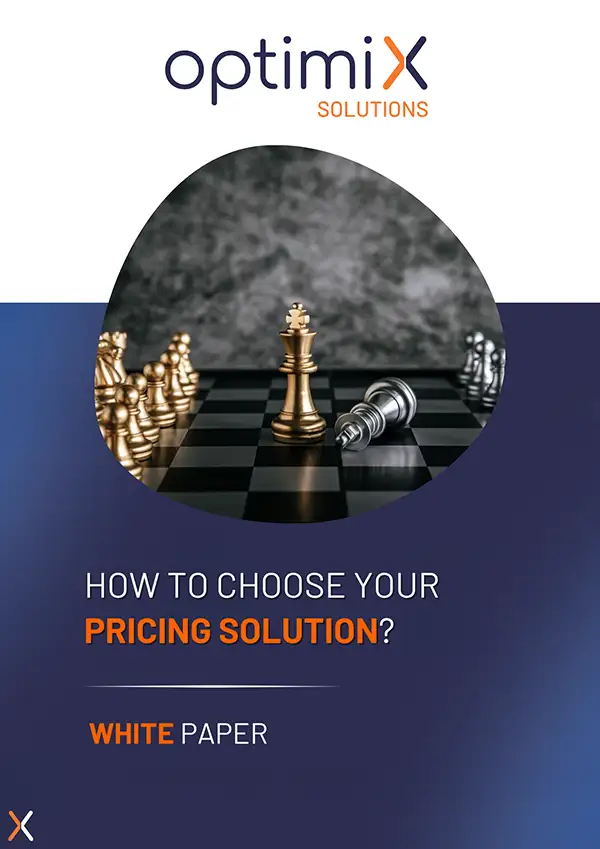Pricing policy is a fundamental lever in a company’s sales strategy. It influences not only customers’ perception of value, but alsotheir competitive position in the market. Yet many companies are faced with a dilemma: how to make an innovative product profitable quickly, while at the same time amortizing the high costs of research and development?
Among the various pricing strategiesskimming strategy is distinguished by its focus on maximizing margins from the moment a product is launched. It involves setting a high price to capture the segments most willing to pay.
In this article, we’ll explore the principles, objectives and conditions for success of a skimming strategy, as part of a coherent, high-performance pricing policy.
What is a skimming strategy?
Skimming refers to a pricing approach in which a high price is set for a new product or service when it is introduced to the market.
This pricing strategy unlike the price alignment strategy involves positioning a product at a price significantly higher than the average for comparable products, with the aim of maximizing profits. The term “skimming” has its origins in consumer selection, which occurs naturally when the price is high.
The aim is to attract those consumer segments willing to pay more for the latest and/or most innovative product.
- What are the advantages of this strategy?
- How do you implement it effectively?
Based on the principle that early adopters or passionate consumers are willing to pay a premium price. What’s more, once this first wave of consumers has been satisfied, the company can gradually reduce the price. Thanks to this price reduction, it can attract a wider customer base.
In fact, this price is carefully chosen to reflect the high-end or luxury image that the company wishes to attribute to the product.
This strategy focuses on maximizing margins rather than sales volumes, with the aim of generating higher financial returns.
Why adopt a skimming strategy?
Price embodies the perceived value of a product and plays a major strategic role in a company’s positioning. This is even more important in the retail sector, where an extra 5 cents on the price of a product can send consumers to your competitors. As one of the pillars of the 4Ps of marketing (Product, Price, Place, Promotion), it directly influences the way an offer is received in the marketplace.
Opting for a skimming strategy means aiming for rapid profitability by targeting a demanding clientele, ready to invest in products perceived as exclusive, innovative or top-of-the-range. This premium positioning not only enhances brand image, but alsoamortizes the high costs associated with research, development and product launch. This approach is particularly relevant in the technology, luxury goods and cultural goods sectors.
Moreover, this strategy opens the way to international expansion, by targeting markets where purchasing power and the search for differentiation are more pronounced. However, for this strategy to work, the high price must be justified by real added value: innovation, exceptional quality or strong brand awareness. It’s not simply a question of selling at a high price, but of selling better to those who recognize its value.
However, implementing this strategy may require high initial costs.
How does the skimming strategy shape consumer perception?
The skimming strategy has a decisive influence on how consumers perceive a product. By setting a high price at launch, the company activates several psychological and marketing levers linked to value, exclusivity and social status.
Firstly, a premium price helps to enhance the product’s value by conferring an image of superior quality. price image. In the consumer’s mind, a high price often refers to technological innovation, top-of-the-range materials or exceptional performance. It is this mechanism that positions the product as desirable and distinctive, particularly in worlds such as high-tech, luxury or fashion.
This approach also plays on the exclusivity effect. First-time buyers, often enthusiasts or customers with high purchasing power, are attracted by the idea of being the first to have access to a rare or innovative novelty. This privilege reinforces the brand image and creates a social status associated with owning the product.
On the other hand, this strategy also generates particularly high expectations. Consumers willing to pay a high price expect an impeccable experience, both in terms of product and service. If these expectations are not met, the boomerang effect can be severe: disappointment, criticism and loss of credibility.
Finally, the high price acts as a natural filter that immediately segments the market. Only consumers convinced of the added value will take the plunge, enabling the brand to target the most profitable and loyal profiles from the outset.
The 8 impacts of a skimming strategy on your price positioning
1. Maximizing initial profits
By setting a high price at launch, the company can achieve high profit margins. When the product is new or innovative and demand is strong. This strategy allows the company to maximize your margins from the start.
2. Positioning premuim
A high price can establish a premium brand image. Consumers often associate higher cost with better quality or high status. The high price helps reinforce the perception of the product as high quality or exclusive.
3. Rapid recovery of R&D costs
For products that require significant investment in research and development, such as drugs or technology. When prices are skimming they can help recover these costs more quickly. This can be particularly beneficial for products that require heavy investment in R&D.
4. Less pressure on production
Sales volume is initially lower with such a pricing strategy. This gives the company time to ramp up in terms of production and distribution.
5. Barrier to entry for competitors
A high price can discourage competitors from entering the market. They might feel that the high-priced segment is already saturated.
6. Demand Optimization
If production capacity is limited at the outset, the cream-skimming policy can help help to avoid excessive demand that cannot be met.
7. Capitalize on early buyers
Early adopters, often less price sensitive, are willing to pay a premium to get the product before others. Implementing a skimming policy takes advantage of this dynamic.
8. Pricing flexibility for the future.
It is generally easier to reduce prices later than to increase them. Once finished, the company can gradually lower its prices. This will allow it to attract new market segments that are more sensitive to price.
Price skimming strategy: how to implement it in your pricing policy?
1A skimming strategy begins with a detailed analysis of consumers’ willingness to pay. Qualitative and quantitative studies identify the segments most inclined to accept a high price. Recognized methods such as Van Westendorp or Gabor-Granger are then used to precisely calibrate the optimal price, based on perceived value and price tolerance.
2. Once this analysis has been carried out, the next step is to define the initial price. This must be well above the market reference price, while integrating the costs associated with innovation, selective distribution and premium-oriented communication. This positioning not only attracts those consumers most sensitive to novelty, but also reinforces the product’s image of exclusivity.
3. The strategy should then include a progressive pricing trajectory, in line with the product’s life cycle. Pricing can be adjusted as adoption broadens: first targeting early adopters, then the early majority, and finally the late majority. This sequencing maximizes profitability in each phase of the market, while keeping pace with product diffusion.
4. rigorous management is essential. Tracking key indicators such as conversion rates, price elasticity and value perception provides a clear picture of performance. Tactical adjustments can then be made according to market feedback and competitor movements, ensuring that the strategy remains relevant and effective over the long term.
Skimming strategies: different approaches for different industries
Although the skimming strategy is relevant in many fields, it must always be adapted to the sectoral context. Indeed, some markets are more conducive to this approach than others, depending on the speed of innovation, the perceived degree of differentiation and consumer sensitivity to price.
1. Technology & consumer electronics
In this sector, marked by rapid and continuous innovation, consumers are often prepared to pay a high price for access to the latest innovations.
Examples: smartphones, televisions, connected objects.
Key factor: the presence ofearly adopters who value early access to products, even at a high price.
2. Health & pharmacy
New drugs and treatments developed through years of research and clinical trials also lend themselves to skimming.
For example, a drug that meets an unmet medical need can be launched at a high price, until competition appears or patents expire.
Advantage: this strategy enables laboratories to recoup part of their R&D investment, while responding to urgent demand.
3. Retail & consumer goods
In the retail sector, innovation is a powerful lever of attraction.
Examples: a drink enriched with a new health ingredient, a functional food, a novel organic product.
Consumer behavior: customers are often curious and willing to try out new products, even if they come at a higher price.
The challenge for retailers: offering unique products that can’t be found elsewhere reinforces the image of innovation and builds loyalty among customers willing to pay more.
4. Other relevant sectors
Luxury and fashion: limited collections, exclusive launches or collaborations create a rarity that justifies high prices.
Automotive: new electric or hybrid models, often offered at a high price before democratization.
Tourism & hospitality: exclusive offers (exploration trips, experiential stays) can be priced high to capture premium customers.
3 examples of skimming strategies
1. LVMH
Louis Vuitton is an internationally recognized brand, particularly in the field of leather goods.
Louis Vuitton targets a high-end clientele concerned about their image. The brand’s high prices can be explained by exclusively French production. But also through the use of quality raw materials and expertise easily identifiable thanks to its logo.
This strategy permeates every facet of the company, from product design to distribution in high-end boutiques designed by renowned architects. These boutiques are conveniently located in the most prestigious districts of major world capitals, such as the emblematic Avenue des Champs-Élysées in Paris.
2. Apple
Steve Jobs founded Apple in the late 1970s. The brand adopted a skimming strategy to market its products. This strategy starts with a high initial price for new models, then Apple gradually reduces this price over time.
When Apple launches a new iPhone, it first sets a premium price to attract fans of the brand, ready to pay more to have it as soon as it is released. Then Apple quickly reduces the price, thereby boosting demand and sales. Once it reaches a large customer base, Apple stops producing the model and removes it from the market.
Apple justifies its high prices by the costs of designing high-end products and by significant investments in research and development to create innovative models with perfect finishes. Apple’s skimming strategy has contributed greatly to its success in the technology sector.
3. Nespresso
The famous Nespresso brand, market leader in coffee pods for over 15 years, has deliberately chosen a “high-end” positioning to distinguish itself from its rivals.
Nespresso runs its own stores and sells coffee machines and pods at much higher prices than competing brands like Senseo or Tassimo.
An entry-level coffee machine from Nespresso costs up to 99 euros, while Senseo offers a model for just 40 euros. Additionally, some Nespresso models, like the Gran Lattissima, can cost up to 500 euros. Nespresso justifies these higher prices by highlighting the superior quality of its machines, equipped with high-performance systems, its patented capsules and its wide variety of coffees. Signing up for the Nespresso Club offers customers benefits such as access to members-only capsules and free tasting sessions.
The consequences of a poorly controlled skimming strategy
Although a source of commercial success, the skimming strategy also has its drawbacks, attracting the attention of competitors eager for additional profits. This is why a company considering adopting this strategy must be prepared to react quickly and effectively to competitors’ actions.
To achieve this, it is essential to monitor competitors and market signals, including both direct and indirect competitors. Additionally, it is imperative to be ready to respond by having innovations in the pipeline.
Mistakes linked to the wrong skimming strategy
- Exclusion of certain market segments: High prices can exclude price-sensitive consumers, thereby reducing your potential customer base.
- Increased competition in the long term: Competitors may adapt by offering cheaper alternatives, which could reduce your sales volumes.
- Negative perception risk: If customers perceive that your prices are excessive compared to the actual value, this can damage your reputation.
- Pressure to maintain quality: Customers expect higher quality at higher prices, which can put pressure on the quality of your products or services.
- Difficulty setting a price You’ll need to constantly justify why your products or services are worth the asking price.
- Reduced loyalty: Customers may be less loyal if they find cheaper alternatives or if you reduce prices.
- Barriers to entry for new competitors Your pricing policy may attract the attention of potential competitors, encouraging them to enter the market with competing products or services.
- Pricing Complexity: Managing price changes and discounts can be complicated and resource-intensive.
- Risk of niche dependence: If you use a skimming strategy for too long, you could restrict your growth by only catering to a specific niche.
- Sensitivity to economic fluctuations: Customers may reduce their spending during an economic downturn, which can affect your sales volume.
———————————–
The skimming strategy is a powerful tool when used under the right conditions. It’s essential to understand your target market and be prepared to adapt quickly based on consumer reactions and competitor moves.
As with any strategy, it is crucial to evaluate it regularly to ensure that it remains relevant and effective.
However, its success depends on market acceptance and the existence of genuine innovations or competitive advantages. It also depends on the company’s ability to adjust its strategy according to market developments.
Skimming Strategy FAQ
What is the skimming strategy?
Skimming strategy is a pricing policy where a product is launched on the market at a high price, targeting consumers willing to pay a premium for exclusivity or innovation.
The aim is to “create the cream” of the market, capitalizing on segments willing to pay more for access to the latest innovations or premium products.
What are the advantages and disadvantages of a skimming policy?
Advantages :
- Profit maximization: By launching the product at a high price, the company can recoup its R&D costs more quickly.
- Exclusivity and Brand Image: A high price can reinforce the perception of quality and prestige, attracting consumers looking to stand out from the crowd.
- Market Segmentation: Allows you to target different market segments successively, adjusting prices progressively to attract new consumers.
Disadvantages :
- Risk of Negative Reaction: Price-sensitive consumers may perceive the company as greedy, which can damage long-term reputation.
- Barriers to entry: A high price can limit the product’s initial accessibility, reducing sales volume and market share.
- Competitive pressure: Rapidly attracts competitors, who may offer alternatives at lower prices, forcing the company to lower its prices sooner than expected.
When to use the skimming strategy?
The skimming strategy is particularly effective for innovative or technological products, where consumers are willing to pay a premium to be the first to own the product.
It’s also a good approach for luxury markets, where exclusivity and prestige play a crucial role in the purchasing decision.
This strategy is recommended when the company has a strong competitive advantage, such as a unique innovation, patents or a recognized brand, and where the risk of rapid substitution by competitors is low.
How to implement a skimming strategy?
To implement a skimming strategy, start with in-depth market research to identify segments willing to pay more for the product.
Then set a high initial price that reflects the product’s innovation and quality. Clearly communicate added value and exclusivity through targeted marketing campaigns.
Regularly monitor market reactions and competition, adjusting prices as necessary to maximize profits while gradually expanding the consumer base.
Finally, make sure you have a strategic plan for the price reduction phase, to maintain long-term interest and competitiveness.
What are some examples of products using the skimming strategy?
Many technology and luxury products use the skimming strategy.
Smartphones, for example, are often launched at high prices to attract early adopters, and then come down in price to attract a wider audience.
Video game consoles follow a similar approach, capitalizing on the initial craze to maximize profits.
In the luxury sector, high-end watches and sports cars are also often launched at very high prices, reinforcing brand image and exclusivity before offering more affordable models.
How does the skimming strategy affect consumer perception?
The skimming strategy can positively affect consumer perception by reinforcing the product’s image of quality and exclusivity.
High prices are often associated with high-quality, innovative and prestigious products, which can attract consumers looking to differentiate themselves.
However, there is a risk that high prices will be perceived as excessive or unjustified, especially if consumers feel that the value of the product does not match the cost. It is therefore crucial to clearly communicate the product’s unique benefits and added value to justify the high price and maintain a positive perception.
What's the difference between a skimming strategy and a penetration strategy?
The skimming strategy and the penetration strategy are opposing approaches to pricing. The skimming strategy consists of launching a product at a high price to maximize initial profits, targeting less price-sensitive consumers.
The penetration strategy, on the other hand, involves launching a product at a low price to quickly win a large market share and discourage the competition.
The former aims to capitalize on high margins on an initially lower sales volume, while the latter seeks to establish a significant market presence from the outset by attracting as many consumers as possible.








